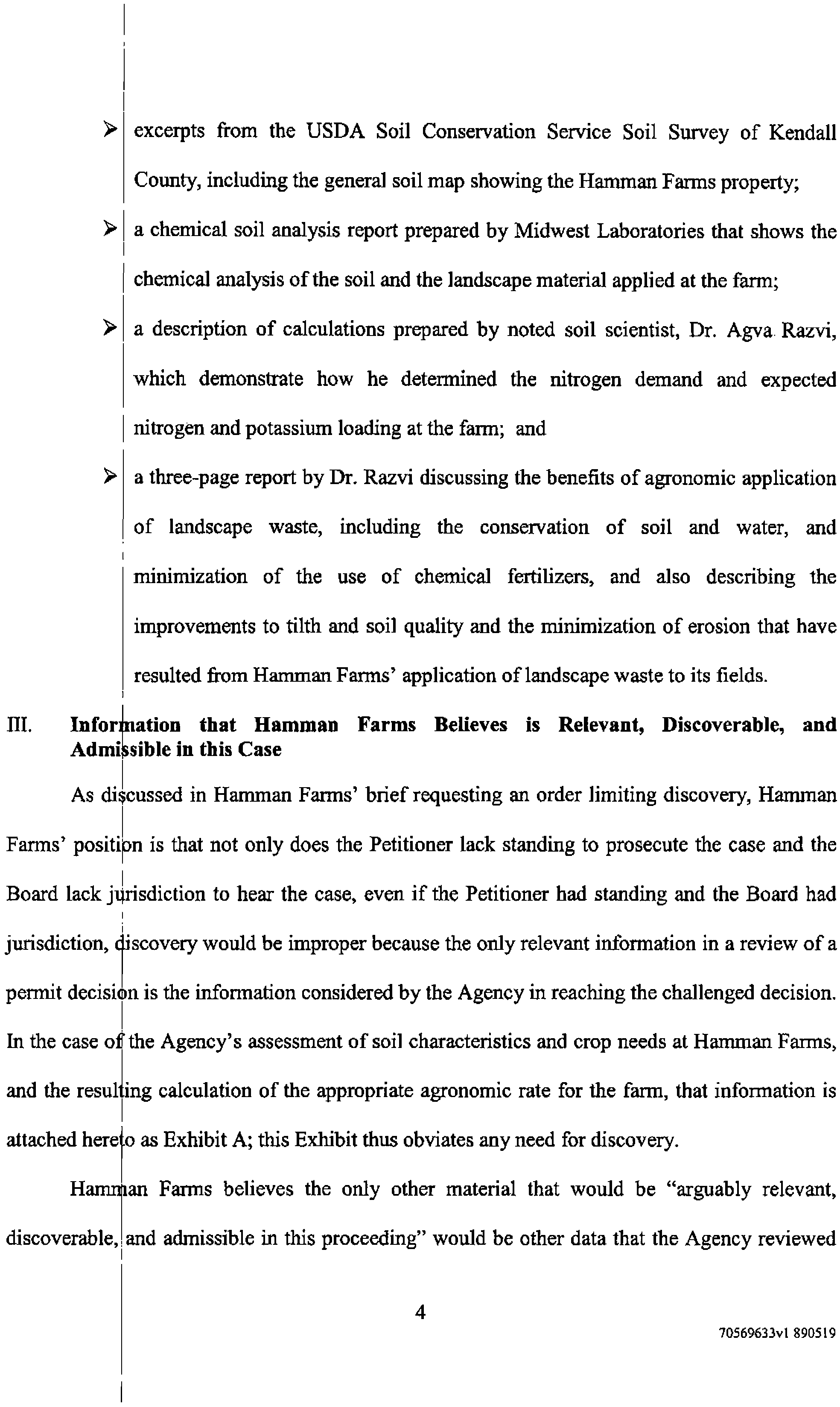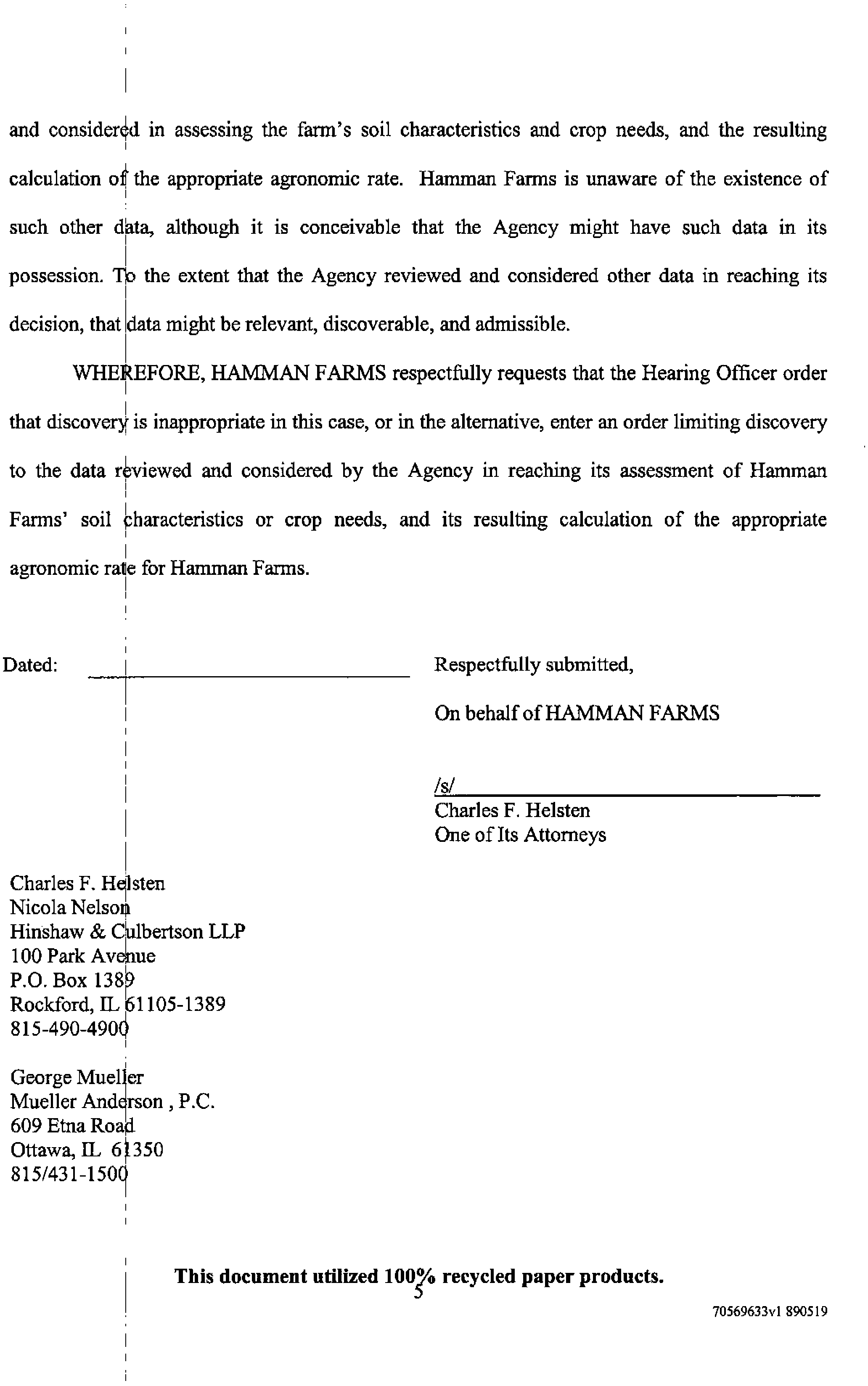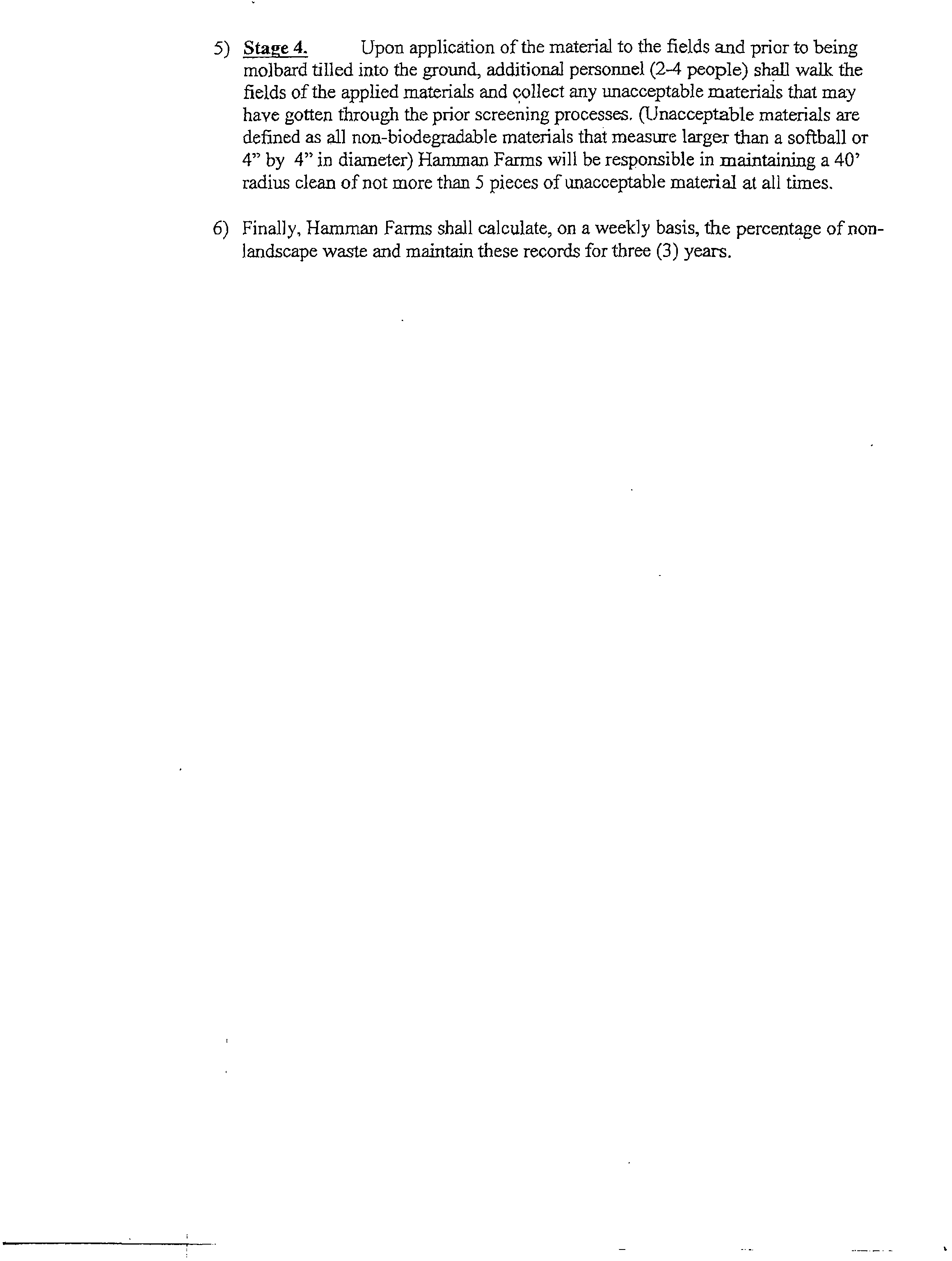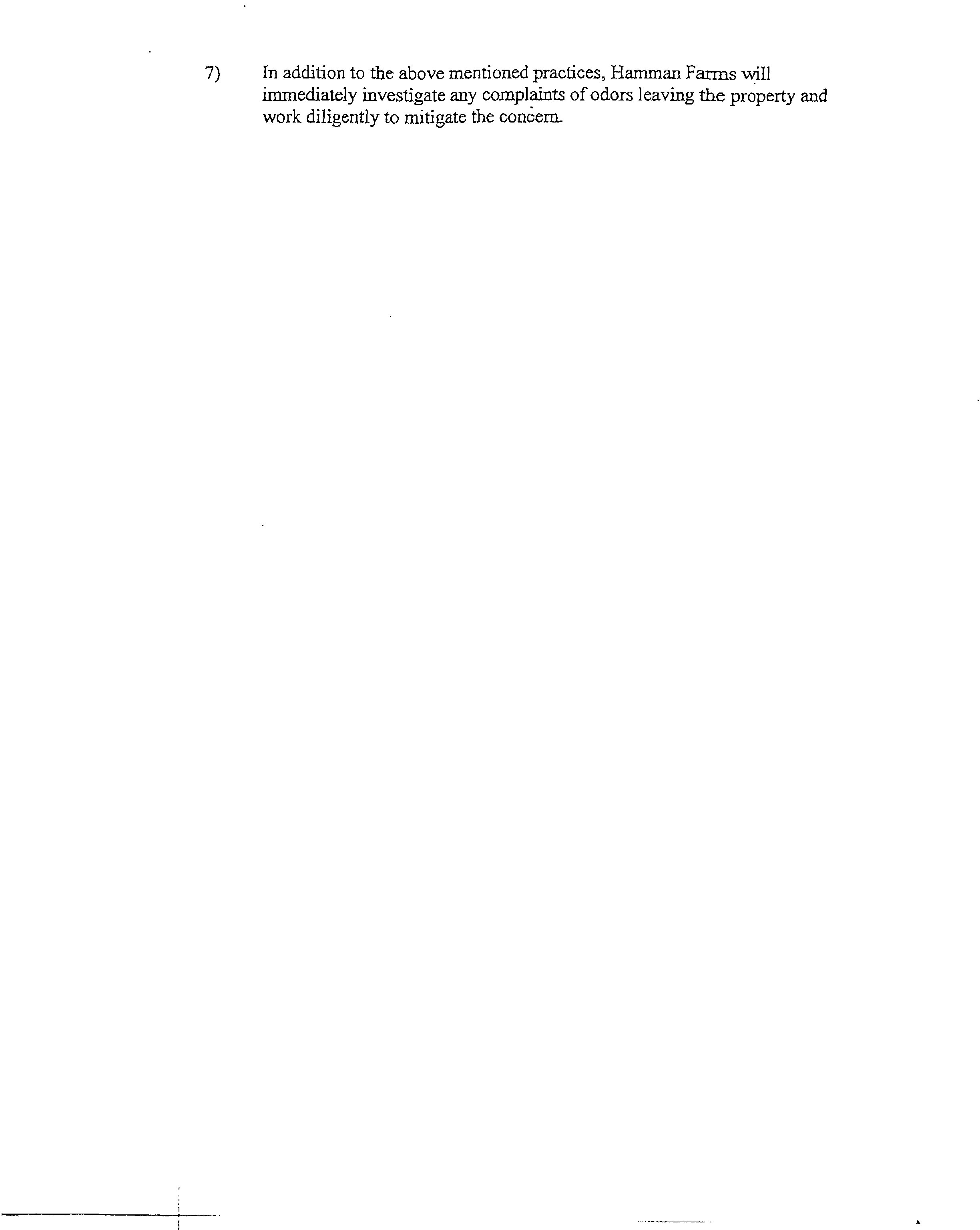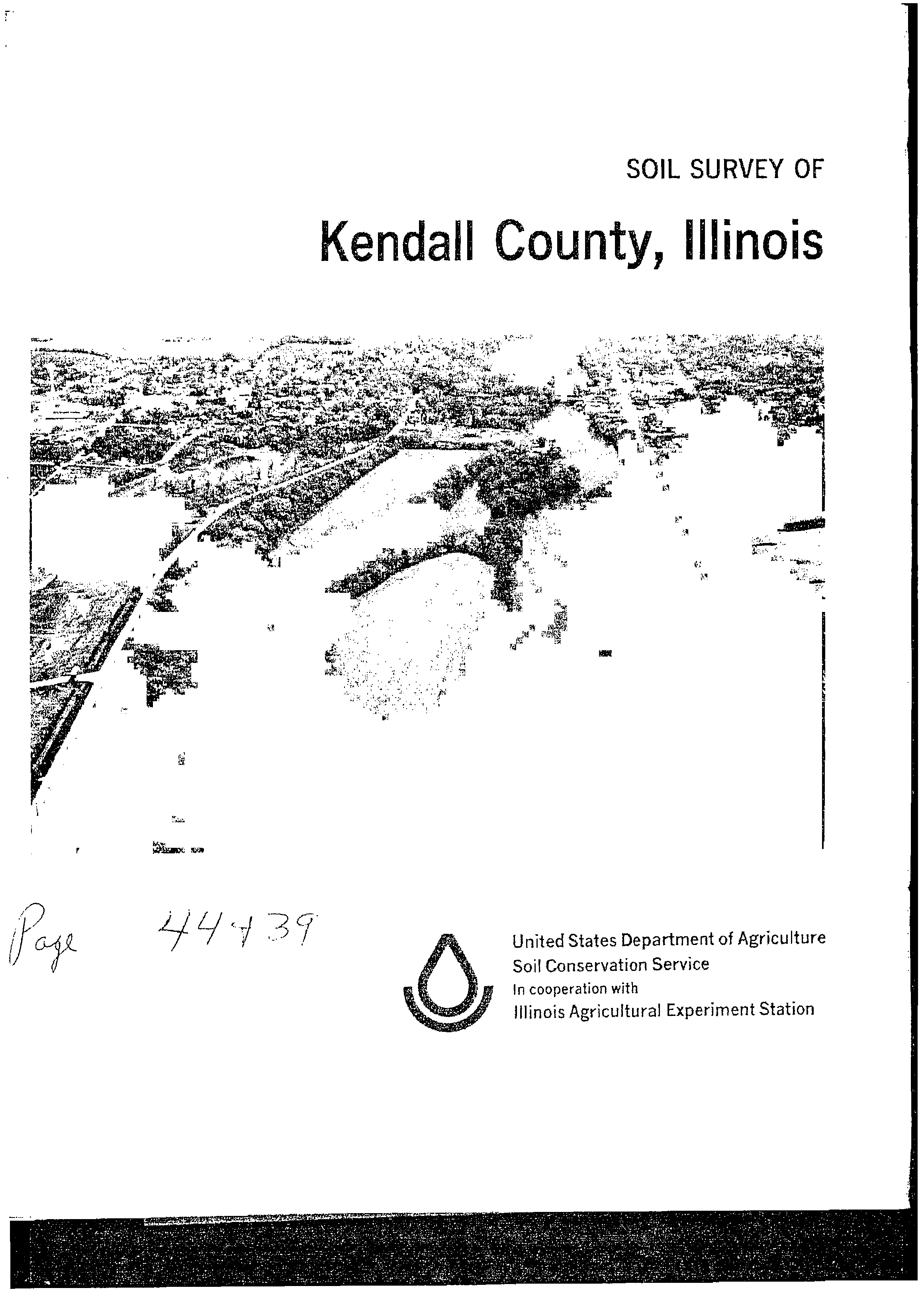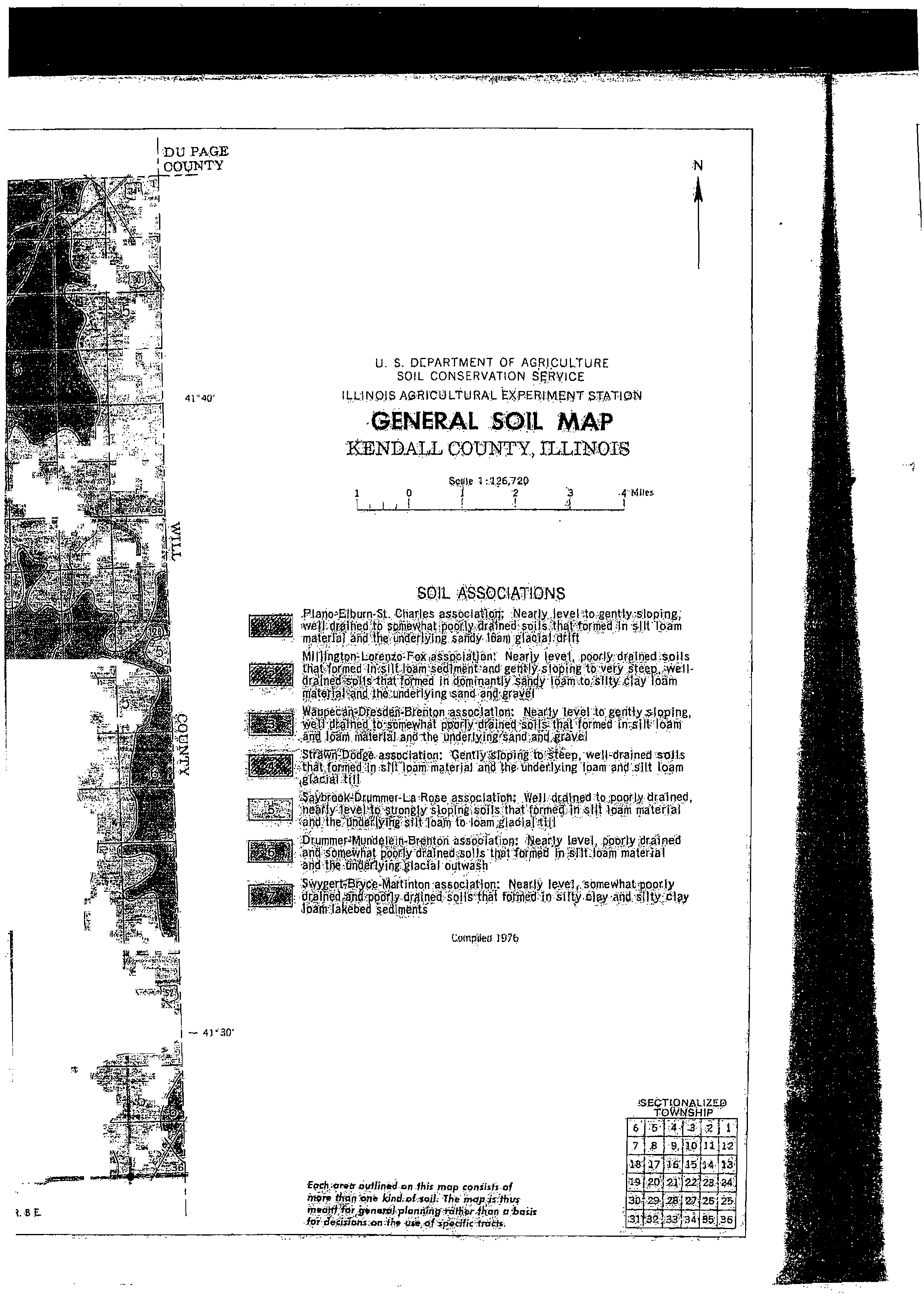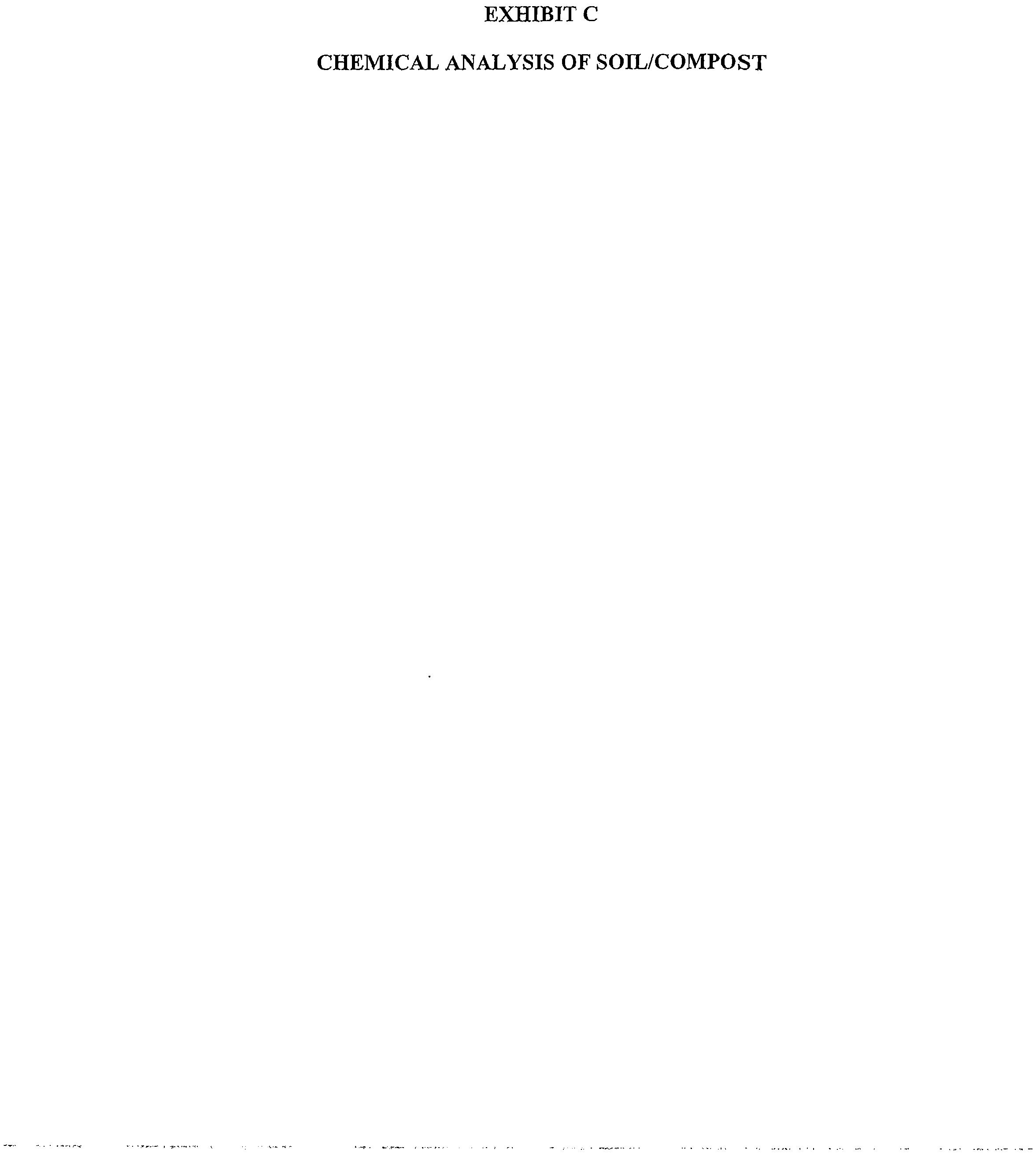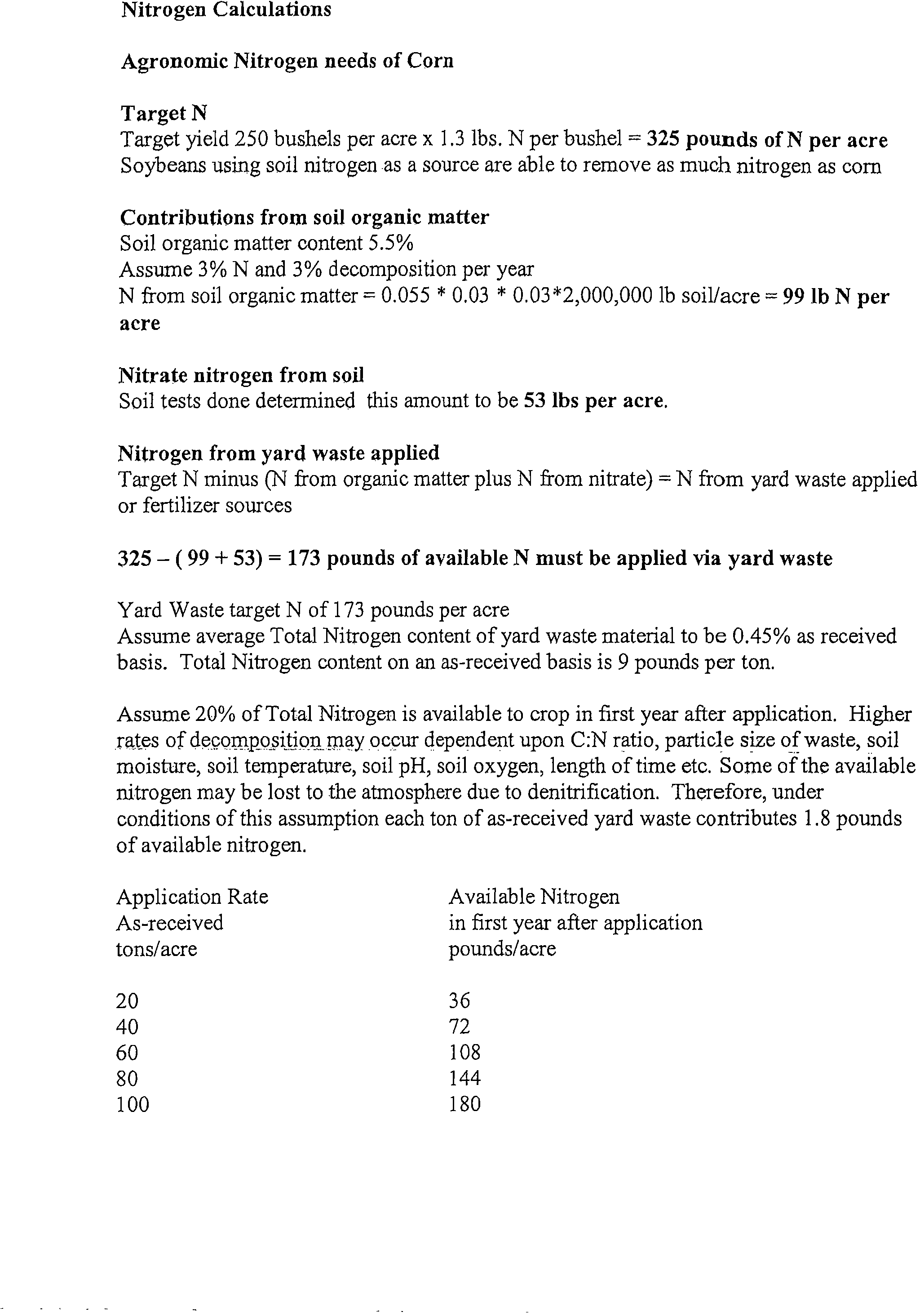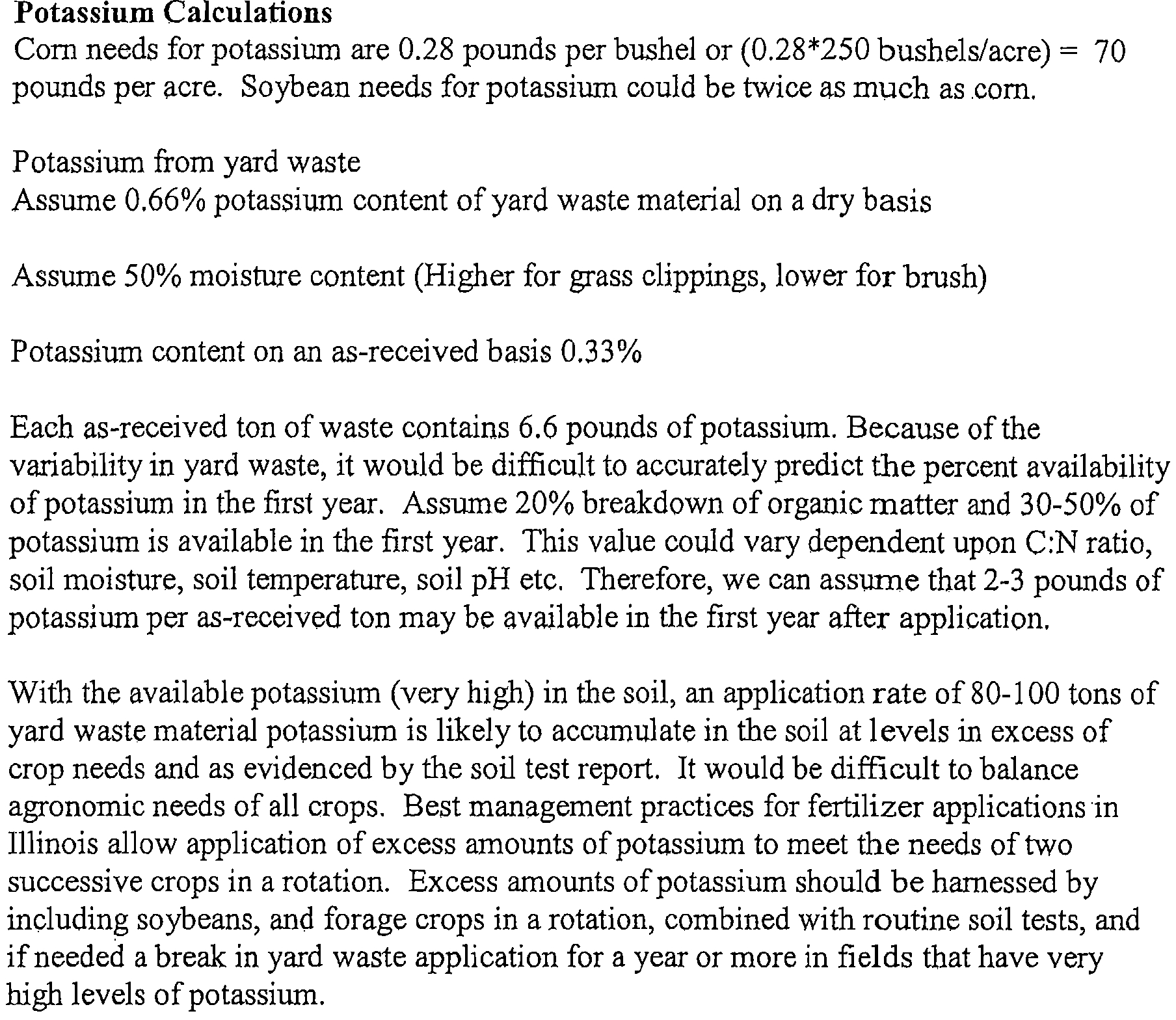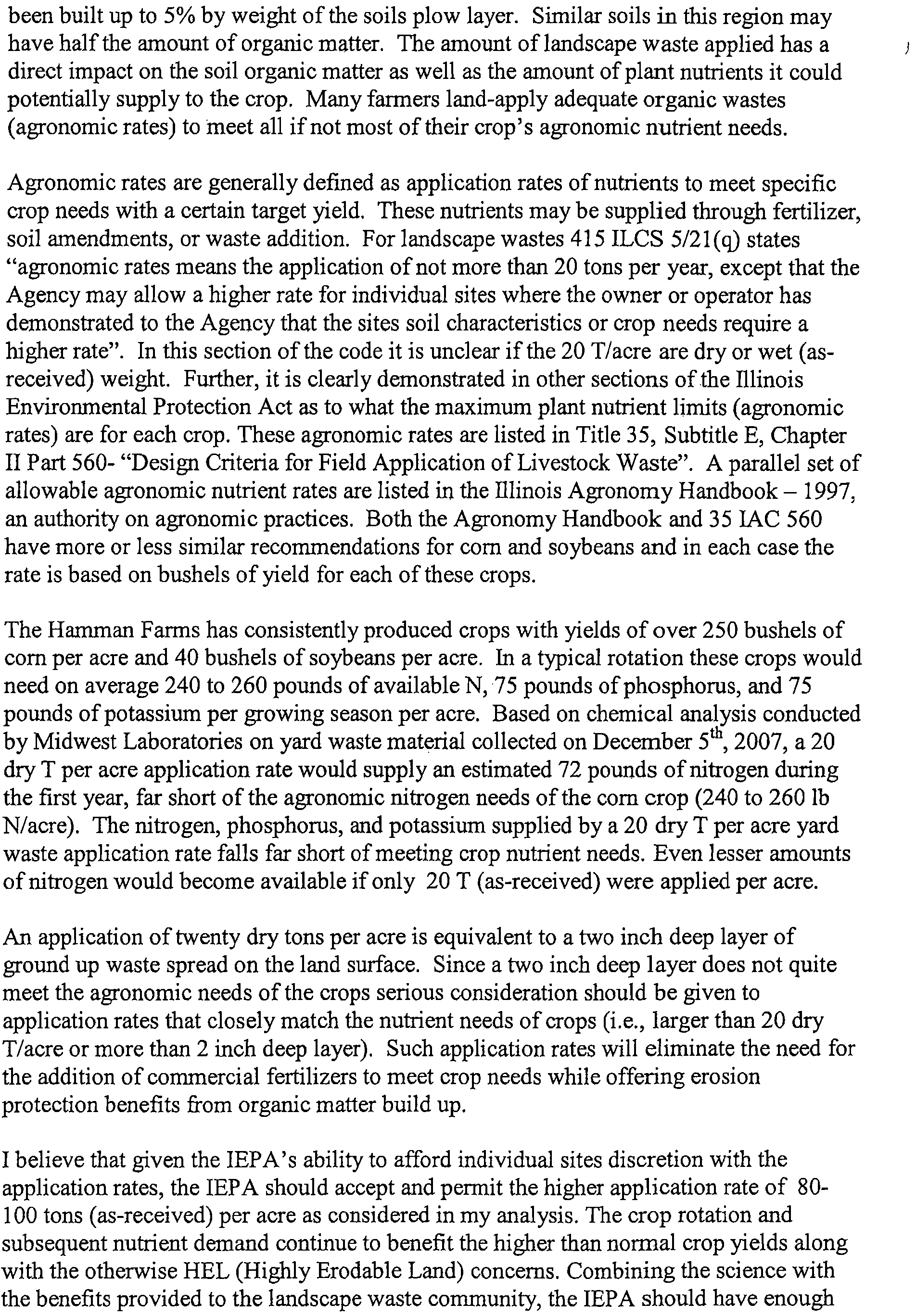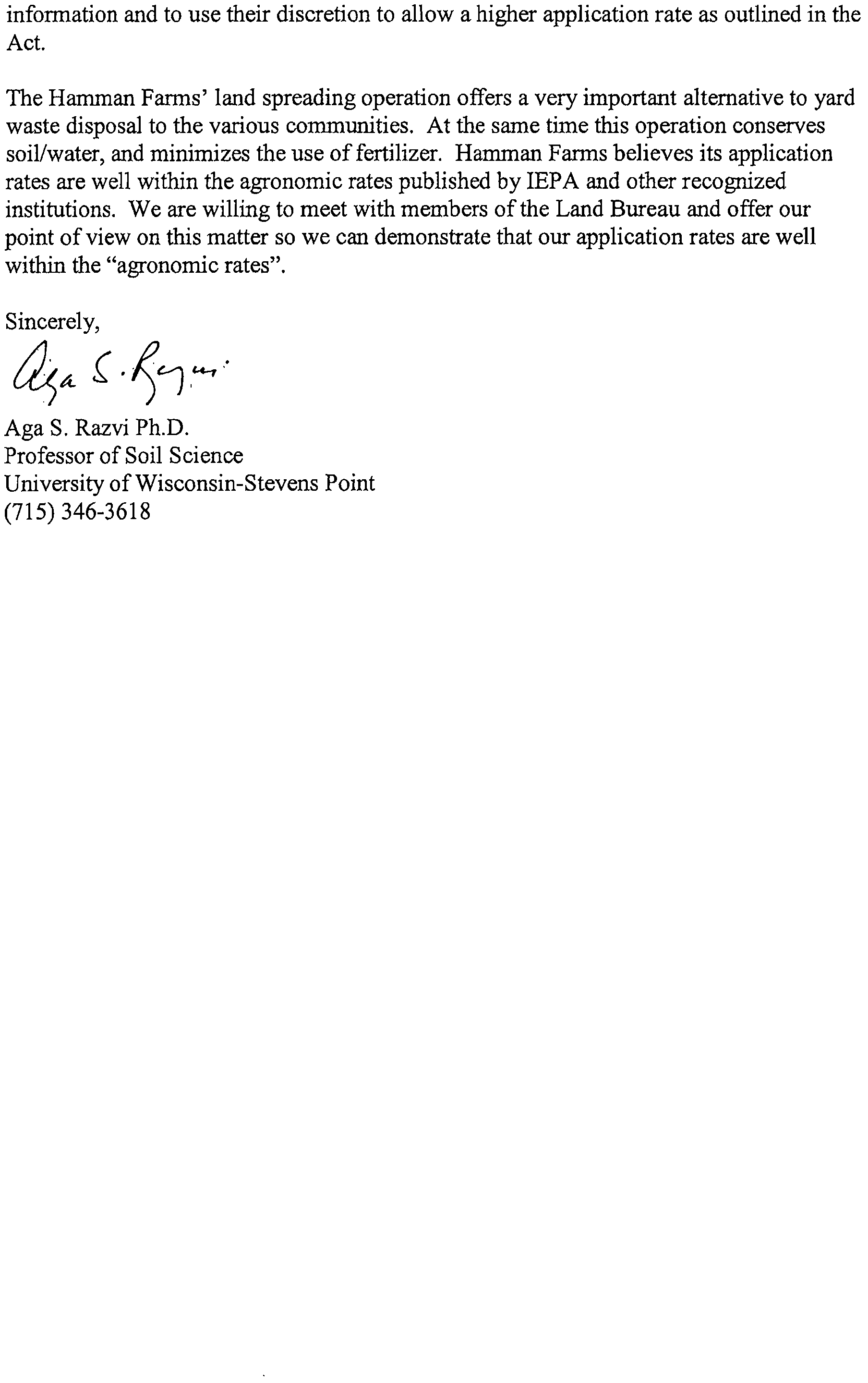PCB No. 08-95
(Appeal of Agency Action)
NOTICE OF FILING
I
BEFORE TIIE ILLINOIS POLLUTION CONTROL BOARD
UNITED CI1j'Y OF YORKVILLE. A
)
MUNlCIPAU CORPORATION,
)
!)
I
,
Petitioner,
~
v.
)
ILLINOISPROTECTI
E~VIRONMENTAL
N AGENCY, and HAMMAN
)
~
FARMS,
)
Respondents.
I
TO: SEE ATfACHED SERVICE LIST
PLEA~E
TAKE NOTICE that on July 31,2008, we electronically filed with the Clerk of
I
the lllinois P llution Control Board. Respondent Hamman Farms' Brief in Response to Hearing
Officer'sJut
24,2008 Order, copies of which are attached hereto and hereby served upon you.
Dated:
Jill! 31, 2008
Charles F. HJlsten
Nicola Nelso*
Hinshaw
&
Culbertson LLP
100 Park
Av~ue
P.O. Box 1389
Rockford, IL
~1105-1389
815-490-490(1)
Respectfully submitted,
On behalfofHAMMAN FARMS
lsi
Charles F. Helsten
One ofIts Attorneys
70566464vl 890519
Electronic Filing - Received, Clerk's Office, July 31, 2008
BEFORE THE ILLINOIS POLLUTION CONTROL BOARD
UNITED
~
OF YORKVILLE, A
MUNICIP
I
CORPORATION,
I
Complainant,
I
v'
PROTECTI
~LINOIS E~VIRONMENTAL
N AGENCY and HAMMAN
FARMS,
Respondents.
)
)
)
)
)
)
)
)
)
)
PCB No. 08-95
(Appeal of Agency Action)
RESPONDENT HAMMAN FARMS' BRIEF IN RESPONSE
TO HEARING OFFICER'SJULY 24, 2008 ORDER
NOW/COMES Respondent, HAMMAN FARMS, by and through its attorneys, Charles
F. Helsten
an~
I
HINSHAW
&
CULBERTSON LLP, and for its Brief
in
Response to the Hearing
Officer's
JUI~
24, 2008 Order, states as follows:
BACKGROUND
This Jction arises from a third-party appeal of the IEPA's calculation of the appropriate
rate for
apPI~ng
landscape waste to the fields at Hamman Fanus.
In
April 2008, Hamman
Fanns reque1ed that
~
!EPA consider the fann's unique soil characteristics and crop needs and
determme
th]'
appropnate agronomIC rate, pursuant to 415 ILeS 5/21(q), which authonzes the
Agency to c culate the proper agronomic rate for farms where the
land's soil characteristics or
crop needs jJtify a rate higher than the statutory default rate of 20 tons per acre per year.
[d.
I
I
Hamnjlan Fanus and IEPA have both moved to dismiss this action, based on the
I
Petitioner's ltck of standing and the Board's lack ofjurisdiction to hear such an appeal, which
Petitioner incorrectly characterizes
in
its briefs as an appeal of the granting of a "permit."
On JJl
Y
23, 2008, Hamman Farms filed a Motion for Hearing Officer's Ruling on
Discovery, iJ which Hamman Farms concurred with the Agency's position that, even if the
Board had
jlsdiction over this action, discovery is clearly inappropriate
in
a ''permitappeal,"
70569633v1 890519
Electronic Filing - Received, Clerk's Office, July 31, 2008
where the
onl~
infonnation relevant to the Board'sreview is the record before the Agency at the
time it made its decision.
See generally,
Hamman Farms' July 23, 2008 Motion and July 24,
onse to Hamman Farms' Motion seeking a ruling on discovery, the Hearing
that the parties file briefs "elaborating on the information they believe is
ant, discoverable, and admissible in this proceeding that was not before the
time the permit was issued." (Hearing Officer'sJuly
24,2008 Order at 1).
The brrden of showing that such information exists is, pursuant to Board precedent, on
the Petitione seeking discovery.
(See, e.g., Des Plaines Watershed,
cited in the Hearing
Officer's Orr). Nonetheless, Respondent states affirmatively that there is no relevant,
discoverable nformation which was not before the Agency at the time it made its decision.
I.
Relev nt Factors in a Request Pursuant to 415 ILeS S/21(q)
As a
eshold matter, it should be remembered that no "permit" was issued to Hamman
Farms for th application
of landscape waste. Under 415 ILCS 5/21(q), no permit is necessary
for a farm
to pply landscape waste to its fields at agronomic rates.
Id.
at 5/21 (q)(2). The term
"agronomic r te
U
is, by definition, "the application of not more than 20 tons per acre per year,
except that t1e Agency may allow a higher
rate
for individual sites where the owner or operator
has
demonstr~ted
to the Agency that the site'ssoil characteristics or crop needs require a higher
rate." 415
mes 5/21.
In
April 2008, Hamman Farms requested that the Agency consider the
fann's soil Jharacteristics and crop needs, pursuant to 415 ILCS
5/21,
and determine the
appropriate
1
1
ronomic rate for its fields.
Beca . e the Agency's calculation
of the appropriate agronomic rate came in response to
I
a request un1er 415 ILCS 5121(q), the sole factors the Agency had to consider were the soil
2
70569633vl 8905]9
Electronic Filing - Received, Clerk's Office, July 31, 2008
I
CharacteriStiJ or crop needs of the subject site; these are, accordingly, the factors at issue in this
I
case.
I
I
II.
The
Dlata
on Which the Agency Relied in Making its Decision
In
assJssing the soil characteristics and crop needs of Hamman Fanns' fields, the Agency
I
reviewed Ha¢man Farms' April 2008 letter with attachments (totaling 26 pages), a copy of
which is
a~hed
hereto as Groop Exhibit A. The packet of data and materials that Hamman
Farms
sUbrni~ed
to the Agency, and on which the Agency presumably relied in determining the
appropriate
a~onomic
rate in light of the soil characteristics and crop needs, included:
!
~
a descriptive overview of the operations at the farm, including the number of
acres to which the material would be applied, the chemical composition and
I
average weight of the materials to be applied, the types of crops planted at
I
Hamman Farms, and the average yields of those crops;
~
I
an explanation of the farm's land application procedures, including: its hours and
I
I
months ofoperation, a description ofthe number and types of employees, a listing
I
I
of the equipment used in processing and applying the material to the fields, and a
I
I
detailed description of how material is handled from the time it arrives on-site to
I
the time it is incorporated into the fields. including a description of tilling and
I
spreading practices designed to prevent transportation of the applied materials
I
into surface waters;
~I
a copy of the farm's litter control plan, which details four (4) stages of litter
I
control. and odor control procedures, which consist of seven (7) component parts,
I
which were developed by Hamman Farms with input from Kendall County
State's Attorney Eric Weis, and Kendall County Solid Waste Director, Marlin
Hartman);
3
70569633vl 890519
Electronic Filing - Received, Clerk's Office, July 31, 2008
I
,
I
I
)0- excerpts from the USDA Soil Conservation Service Soil Survey of Kendall
County, including the general soil
map showing the Hamman Fanns property;
»1
a chemical soil analysis report prepared by Midwest Laboratories that shows the
I
I
chemical analysis of the soil and the landscape material applied at the fann;
~
I
a description of calculations prepared by noted soil scientist, Dr. Agva. Razvi,
which demonstrate
how he detennined the nitrogen demand and expected
I
nitrogen and potassium loading at the fann; and
)- a three-page report
by Dr. Razvi discussing the benefits of agronomic application
of landscape waste, including the conservation of soil and water, and
minimization
of the use of chemical fertilizers, and also describing the
improvements to tilth and soil quality and the minimization
of erosion that have
resulted from
Hamman
Fanns'
application of landscape waste to its fields.
III.
Inforfuation that Hamman Farms Believes is Relevant, Discoverable, and
Admi~sible
in this Case
As dilcussed in Hamman Fanns' brief requesting an order limiting discovery, Hamman
Fanns'
Positi~n
is that not only does the Petitioner lack standing to prosecute the case and the
Board lack JJrisdiction to hear the case, even if the Petitioner had standing and the Board had
I
i
jurisdiction, rscovery would be improper because the only relevant information in a review of a
permit decisiam is the information considered
by the Agency
in
reaching the challenged decision.
I
In
the case otthe Agency's assessment of soil characteristics and crop needs at Hamman Farms,
and the resulling calculation
of the appropriate agronomic rate for the farm, that infonnation is
I
attached here
l
as Exhibit A; this Exlnbit thus obviates any need for discovery.
Ha.nuyan Fanns believes the only other material that would be "arguably relevant,
discoverable,'and admissible
in
this proceeding" would be other data that the Agency reviewed
I
4
70569633v1890519
Electronic Filing - Received, Clerk's Office, July 31, 2008
and
consider~d
in assessing the fann's soil characteristics and crop needs, and the resulting
I
calculation ot the appropriate agronomic rate. Hamman Fanns is unaware of the existence of
I
such other data, although it is conceivable that the Agency might have such data
in
its
I
I
possession.
Th
the extent that the Agency reviewed and considered other
data
in reaching its
I
decision, that
ldata
might be relevant, discoverable, and admissible.
I
WHEREFORE, HMv1MAN FARMS respectfully requests that the Hearing Officer order
I
that
discov~
is inappropriate
in
this case, or
in
the alternative, enter an order limiting discovery
to the data
r~viewed
and considered by the Agency
in
reaching its assessment of Hamman
I
I
Fanns' soil ¢haracteristics or crop needs, and its resulting calculation of the appropriate
I
I
agronomic ra1e for Hamman Fanns.
I
I
I
Dated:
1-----
I
I
I
I
I
I
I
I
Charles F. H41sten
Nicola
Nelsoljl.
Hinshaw
&
QJ1bertson LLP
100 Park Avenue
P.O. Box
138~
Rockford, IL 61105-1389
815-490-4900
I
I
George Muel'er
Mueller And4rson,
P.C.
609 Etna
Roa~
Ottawa, IL
6~350
8151431-150q
Respectfully submitted,
On behalf of HAMMAN FARMS
lsi
Charles F. Helsten
One of Its Attorneys
This document utilized 1
OO~
recycled paper products.
70569633v1 890519
Electronic Filing - Received, Clerk's Office, July 31, 2008
j
AFFIDAVIT OF SERVICE
The
dersigned, pursuant to the provisions of Section 1-109 of the Illinois Code of Civil
I
Procedure, hereby under penalty ofpeIj ury under the laws of the United States of America,
certifies that
on July 31,2008, she caused to be served a copy of the foregoing upon:
I
Mr. Jo1m T. 'Ijheniault,Assistant Clerk
via e-mail
Illinois Pollution Control Board
Thomas
G. Gardiner
100
W.
Rand~lph,
Suite 11-500
Michelle M. LaGrotta
Chicago,
IL 6b601
GARDINER KOCH
&
WEISBERG
therriaj@ipcb.st;lteJl.us
53 W. Jackson Blvd., Ste. 950
(via
electron~c
nting)
Chicago,
IL
60604
I
tgardiner@gkw-Iaw.com
mlagrotta@gkw-Iaw.com
viae-mail:
via emaill
Michelle
Ry~
Bradley P. Halloran
Division
ofUgal Counsel
Hearing Officer
Illinois
Envir~nmental
Protection Agency
Illinois Pollution Control Board
1021
N.
Granh
I
Avenue East
James
R.
Thompson Center, Suite 11-500
P.O. Box
192V6
100 w. Randolph Street
Springfield,~
62794-9276
Chicago,IL 60601
Michelle.RyaP@Illinois.gov
ballorab@ipcb.state.il.us
A copy ofthe
Isame
was enclosed in an envelope in the United States mail at Rockford, Illinois,
proper
postag~
prepaid, before the hour of 5:00 p.m., addressed
ave.
I
i/
I
PCB No.
08-~5
Charles F. Hejlsten
Nicola
A
Ne~son
HINSHAW
&
CULBERTSON
I
100 Park Avenue
P.O. Box
1389
Rockford, IL bl105-1389
(815)
490-49QO
I
I
70566472v] 8905]9
Electronic Filing - Received, Clerk's Office, July 31, 2008
HINSHAW
& CULBERTSON LLP
April 10, 2008
Mr. Derek Rompot, BOL #33
Permit Engineer, Disposal Alternatives Unit
Bureau
of Land, IEPA
1021 North Grand Avenue East
P. O. Box 19276
Springfield, IL 62794-9276
Re:
Hamman Farms (0930155023)
Kendall County
Dear
:t\-1r. Rompot:
ATTORNEYS AT LAW
100 Park Avenue
P.O. Box 1389
Rockford,IL61105-1389
815-490-4900
815-490-4901 (fax)
www.hinshawlaw.com
I have received the March 17, 2008 Memorandum prepared by Steve Nightingale in response to
Hamman Farms' request, pursuant to 415 ILCS 5/21(q), that the Agency exercise its statutory
authority to raise the application rate oflandscape waste to the fields at Hamman Farms. I
appreciate the Agency's careful consideration of this request. Hamman Farms is mindful ofthe
General Assembly'sintent, in enacting the Illinois Environmental Protection Act ("the Act"), to
ensure'thatthe State fulfills its duty to "minimize environmental damage... [and] to promote the
development of technology for environmental protection and conservation ofnatural resources"
and "restore, protect and enhance the quality of the environment." 415 ILCS 5/2(a)(iv); 415
ILCS 5/2(b). Hamman Farms' request is fully in keeping with that purpose, and will,
if granted,
help to further the Act's goals.
As you know, the determination was made back in 1990 that it is inappropriate and inefficient to
dispose oflandscape waste in solid waste landfills.
In
addition to creating a system to establish
and regulate commercial landscape waste disposal sites, the Legislature has also recognized that
it is
cle~rly
in the public interest to encourage recycling and reuse of waste materials, both by
individli'a1s, and by large-scale enterprises. (415 ILCS 5/20(a), (c)). The Act accordingly
provides that those who alleviate pressure on landscape waste disposal facilities by applying
landscape waste to farm fields for agronomic purposes are exempt from the rigorous regulatory
mechanisms and processes that govern commercial sites. The decision to exempt those who
apply landscape waste to farm fields from rigorous mechanisms reflects the Legislature's
understanding that encouraging the re-use oflandscape waste will not only minimize the volume
of waste being deposited in large-scale disposal sites, it will also benefit the soil that receives the
application by preventing erosion, improving tilth, and increasing productivity without the use of
chemical fertilizers (thereby minimizing negative impacts on water quality).
In
addition, the
legislature clearly understood that such application provides a valuable service to landscape
waste generators
by offering a convenient, cost-effective, eco-friendly way to dispose of
70556621 vI 883705
Arizona California Florida Illinois Indiana Massachusetts Minnesota Missouri
New York Oregon Rhode Island Wisconsin
Electronic Filing - Received, Clerk's Office, July 31, 2008
Mr. Derek Rompot, BOL #33
April 10, 2008
Page 2
~andscape
waste. In summary, the agronomic application of landscape waste consistent with the
soil.characteristics and crop needs
of a particular site constitutes a "full circle" resource recovery
plan w4ich affords multiple environmental benefits.
. . .
.
As you'know, pursuant to 415 ILCS 5/21 (q), landscape waste may be directly applied to fields at
an agronomic rate defined generally as 20 tons per acre per year. However, in setting this rate,
the legislature gave the Agency the discretion to allow an increased application rate
if a farm
owner or operator demonstrates that local soil characteristics or crop needs justify a higher
application rate.
In
the case of Hamman Farms, the soil characteristics and crop needs do,
indeed, justify a higher application rate.
Hamman Farms' land is classified as Highly Erodable Land (HEL). Through application
of
landscape waste, the farm soil has gradually improved in recent years. As noted in the attached
report prepared
by Dr. Aga Razvi, Ph.D. 1, a noted soil expert and professor at the College of
Natural Resources, University of Wisconsin - Stevens Point, careful management and
application oflandscape waste has enabled Hamman Farms to consistently produce high crop
yields for the last fifteen years, while at the same time conserving soil and water, and minimizing
the use
of chemical fertilizers.
Dr. Razvi'sreport observes that in a typical rotation, the crops grown at Hamman Farms would
require, on average, 240 to 260 pounds
of available nitrogen, 75 pounds of phosphorous, and 75
pounds ofpotassium per growing season per acre. Under the statutory agronomic rate, if
measured at its dry weight, 20 tons of landscape waste would supply only 72 pounds of nitrogen
for the soil during the first year. Obviously, this number falls far short
of the 240 to 260 pounds
needed
to sustain acceptable yield levels. The shortfall is even more dramatic if the 20 ton
statutory rate is measured at its "as-received" weight, rather than its dry weight, due to the much
higher water content when in that state.
At the statutory, agronomic rate of 20 tons, Dr. Razvi notes that soil losses on the Hamman HEL
land can only be maintained at a more or less minimal, "tolerable" level. Allowing Hamman
Farms to move beyond maintaining "tolerable soil losses," and to instead apply 80 tons
of
landscape waste per year would allow Hamman Farms to improve the quality and productivity of
this HEL land, while at the same time, minimizing erosion and eliminating the need for chemical
fertilizers. Moreover, allowing a higher rate
of application would significantly decrease the
volume
of waste that would otherwise be deposited in commercial landscape waste disposal
sites. As a result, allowing a greater rate
of application, as provided under Section 21 (q), would
further the Act'spurpose
of conserving natural resources and enhancing the environment.
In
the attachment to Steve Nightingale'sMarch 17, 2008 correspondence, Mr. Nightingale
proposed
that Hamman Farms provide information to support its pending request for an increase
to the application rate.
It
is worth noting that in evaluating the materials provided with this
application, the sole relevant inquiry prescribed
by the Legislature is whether the farm's soil
I
A copy of Dr. Razvi's letter is attached to this application as
Exhibit E.
70556621vl 883705
Electronic Filing - Received, Clerk's Office, July 31, 2008
Mr. Derek Rompot, BOL #33
April 10, 2008
Page 3
characteristics or crop needs (the designated criteria listed at Section
21 (q)), justify the requested
application rate
of 80 tons per acre per year.
That being noted, for its response to the requests for information listed
in "Attachment A" of the
March 17, 2008 Nightingale Memorandum, Hamman Farms responds as follows:
•
With respect to the amount
of acreage available to receive application of landfill
waste each month, 2,200 acres are available. The method used
to apply the
material to the fields is fully described in the attached
Exhibit
A, which
incorporates an explanation
of Hamman Farms' operations and application
procedures, along with its litter control plan and odor control procedures, which
were developed with input from Kendall County State's Attorney Eric Weis, and
Kendall County Solid Waste Director, Marlin Hartman.
•
In
response to the request for documentation concerning the classification of the
soil, excerpts from the USDA Soil Conservation Service Soil Survey
of Kendall
County are attached
as
Exhibit B.
•
Materials concerning the requested chemical analysis of the soil and compost are
attached to this letter
as
Exhibit C.
•
The requested documentation concerning the nitrogen demand used to determine
the appropriate agronomic rate
of compost application and calculations
concerning the expected nitrogen and potassium loading to the soils,
as provided
by Dr. Razvi, are attached
to this letter as
Exhibit D.
•
No other soil additives are used at the site.
•
As noted above, and
as documented in Dr. Razvi's report, attached as
Exhibit
E,
the application
of landscape waste at Hamman Farms is improving tilth and soil
quality, thereby minimizing erosion.
•
Recordkeeping is described in the "Operational Summary" provided in Group
Exhibit
A.
•
As described in the Operational Summary, in order to prevent the transportation
of applied materials into surface waters, Hamman Farms does not spread or till
within
25 feet of drainage ways.
It
should also be noted that landscape waste is
field applied the same day it is received, and is thoroughly incorporated into the
soil through a 2-step tilling process (described in the Operational Summary),
which surpasses the requirements
of the Act; these procedures effectively prevent
the applied material from traveling into surface waters.
In light
of the information and documentation provided herein, and given the benefits of
dramatically improved soil quality, improved water quality (through elimination of the use of
chemical fertilizers), minimization of surface water runoff, increased productivity, and decreased
70556621vl883705
Electronic Filing - Received, Clerk's Office, July 31, 2008
Mr. Derek Rompot, BOL #33
April 10, 2008
Page 4
pressure on commercial landscape waste disposal sites, Hamman Farms' request that it
be
allowed to apply landscape waste at a rate of 80 tons per year should be granted because it would
further the purpose of the Act by helping to restore, protect and enhance the quality of the
environment. The request is, therefore, appropriate under 415 ILCS 5/21(q).
Because Hamman Farms' operational season is upon us, and disposal pressures in the
marketplace are intensifying and must
be addressed, I look forward to receiving approval ofthe
requested application rate at the earliest possible opportunity.
If you have any questions or would like to discuss this matter further, please do not hesitate to
call me.
Sincerely,
HINSHAW
&
CULBERTSON LLP
..
--
~~
I)
/('0
J
/"'-'"
1
"'.
~.
".
,j.
".:'~.::::~"'.
"~
,\\
\\
..
."
/I
.
.
.i
/
g,
( !
\; 1
L=~~).I
,v'
~-~'
\~,_/",
,,/
\
'\,,~'l
\)}
ul
...1
r../
II (
Charles F. Helsten
815-490-4906
che1sten@hinshaw1aw.com
CFH:nn
Enclosures
cc:
Don Hamman
Eric Weis
Marlin Hartman
70556621vl883705
Electronic Filing - Received, Clerk's Office, July 31, 2008
EXHIBIT A - LAND APPLICATION PLAN
Electronic Filing - Received, Clerk's Office, July 31, 2008
APPLICATION PLAN - OVERVIEW
The rate and methodology of the application of landscape waste to the fields at Hamman Fanns
can best be understood by beginning with a simple mathematical overview
of the amount of
waste that is proposed to be applied, and the amount of acreage that would receive the waste.
Hamman Fanns proposes to accept
up to 9,387 loads of landscape waste annually, with an
average of 75 cubic yards per load. This would result in 704,025 cubic yards of waste material.
While the weight
of a cubic yard of landscape waste varies depending on its content (i.e. fallen
leaves are much lighter than fresh-mown grass clippings), on average the weight
of such waste is
500 pounds per cubic yard. When the number
of cubic yards (704,025) is multiplied by the
average weight per cubic yard (500 pounds), the result is a total
of 176,006 tons of landscape
waste per year.
Hamman Fanns has 2,200 acres that would be available to receive application
of the proposed
176,006 tons
of landscape waste. This would represent an annual application rate of 80 tons per
acre. The rate of application is uniform throughout the acres in use because, as a practical matter,
it is virtually impossible to super-apply the material to a particular spot, given that the applied
material
is plowed in every day, causing the soil to become loose and soft. Once material has
been plowed in to a given area, the molboarding equipment would become bogged down and
unable
to operate if an attempt was made to re-apply to that same area within a given year.
The Hamman Fanns protocol
of spreading and plowing the material into the fields the same day
it
is received not only avoids odor problems, it also decreases erosion of the farm's HEL soil,
and prevents sheeting off of rainwater from the fields. The efficient manner in which Hamman
Fanns processes the landscape waste it receives provides additional environmental benefits,
including increased nutrient supply and retention that eliminates the need for application
of
artificial fertilizers to the fann's fields, and improved moisture retention. These improvements to
soil quality, coupled with the resulting increased aeration, have led to outstanding productivity
over the last fifteen years, with yields
of 250 bushels per acre of corn, 50 to 70 bushels per acre
of soybeans, and 90 to 110 bushels of winter wheat per acre. At the same time, Hamman Farms
has been able
to keep a substantial amount of landscape waste out of Illinois landscape waste
disposal sites, and offers a value service to !fiunicipalities and waste haulers in their attempts to
manage the waste needs
of urban and suburban landowners.
The documents in the Land Application Plan which follows (collectively, Group Exhibit A)
provide a description
of the fann itself, its employees, its equipment, its protocols for handling
waste from the moment it arrives at the site
to the time it is plowed into the fields, its litter
control plan, and its odor control procedures.
70558424vl 883705
Electronic Filing - Received, Clerk's Office, July 31, 2008
FACILITY OPERATIONS and APPLICATION RATE
HAMMAN
FARMS LLC
1994
2,200 acres
2.0 acres
April 1st - January lOth
January
11 - March 31st
6:00AM - 5:00PM
6:00AM - 12:00PM
Daily Processing
Employees:
Equipment:
Commencement of Operations
Subject Site owned and/or controlled and farmed by Don
&
Carol Hamman
Staging Area for IncomingIReceivinglProcessingILoading
Approximate Open Season
Closed
Receiving Hours - Monday through Friday
Receiving Hours - Saturday
All landscape material received is processed and field applied that day
1x General Manager
Ix Site Supervisor
3x Equipment Operators
3x Full Time Pickers
Ix Komatsu 470 Wheel Loader (Pushes material to Tub Grinder and loads Spreaders)
Ix Vermeer Model 700 Tub Grinder (1,000 hp with 400-500 cubic yardlhr capacity)
Ix Cat 330 Excavator with 8 yard Grapple (loads material into Tub Grinder)
2x Morlang 20 yard Spreader
Ix 9520 (475 hp) John Deere 4x4 Tractor with Case IH 9 shank ecology Chisel Plow
Ix Case IH (530 hp) Quad Tractor with 10 bottom John Deere Molboard Plow
Ix Roll-Off box for reject material and picked plastic.
Ix New 20 yard Spreader (delivery in July)
Operational Summary:
Landscape material arrives in trailers or trucks during operating hours and is directed to unload at the designated unloading/processing
area. Employees pick non-conforming material during the unloading. A rubber tire wheel loader moves material from the unloading area
to the processing and/or grinding stockpile. The excavator moves landscape waste from the stockpile into the tub grinder. The tub grinder
processes material until it passes through a 5"x5" diamond shaped screen. Processed material is then loaded into spreading trucks that
transport and spread material in the designated field. Material is first chisel plowed into the field, then molboard plowed (a 2 step process
that fully incorporates the material
into
the field).The facility supervisor collects load tickets from each driver and notes the area where the
material has been applied. A field does not receive more than I application per year. Material is not spread within 25 feet
of drainage ways
to prevent transportation ofapplied materials into surface waters. Material is processed and field applied the
day
it is received.
Continued investment in proper equipment allows the site
to remain open and fully operational during inclement weather.
Pickers/laborers control waste
by patroling the unloading/processing area as well as the fields, ditches, and roads at and near the Subject
Site.
Soil Management and Crop Yield:
Soil Survey literature shows the Subject Site is generally associated with Saybrook-Drummer-La Rose series ofsoils, so protecting the
soil from erosion and increasing its organic matter content are major soil management concerns. Application
of processed landscape waste
provides several benefits, including increased aeration, nutrient supply and retention; improved moisture retention; and decreased soil
erosion. As a result, Hamman Farms has consistently produced crop yields
of250 bushels of corn per acre, 50 to 70 bushels ofsoybeans
per acre, and
90 to 11 0 bushels of winter wheat per acre.
Proposed Application Rate
Scenario 1
Scenario 2
Scenario 3
Lighter
Average
Heavier
Loads of Landscape Material
(A)
9,387
9,387
9,387
(Ids/yr)
Average Cubic Yards per Load
(B)
75
75
75
(cy/load)
Annual Cubic Yards
(C)
(A*B)
704,025
704,025
704,025
(cy/year)
Acres Applied (estimated)
(D)
2,200
2,200
2,200
(acres)
Cubic Yards/Acre
(E)
(CID)
320
320
320
(cy/acre)
Loads/acre
(F)
(AID)
4.3
4.3
4.3
(loads/acre)
Average Lbs/Cubic Yard
(G)
400
500
600
(Ibs/cy)
Tons
(II)
(C*G)/2000
140,805
176,006
211,208
(tons)
Tons/Acre
(I)
(HID)
64
96
(tons/acre)
Electronic Filing - Received, Clerk's Office, July 31, 2008
Litter Control Procedures
Hamman Farms
Hamman FamlS has
prepar~
this Litter Control Plan to develop a standard operating
procedure for the acceptance
of yard waste materials from miscellaneous landscapers and
other transporters to assUre compliance with IEPA guidelines.
Hamman Farms recognizes
the need to establish and enforce a set
of guidelines not only for compliance as well
establish themselves as a good neighbor. Hamman
F<:lfI1Js is committed to enforcing and
maintaining
the procedures as outlined below.
The Litter Control P'lan consists of the following components:
1) All parties delivering material to Hamman
Fanns shall be notified prior to
delivery and dumping that litter/general refuse are not acceptable for disposal at
this facility. In addition to notifying
aU parties delivering material to the facility,
Hamman Farms shall also notify all employees
of the Litter Control Plan.
2) Stage
1.
AU loads will be screened by Hamman staff as they are unloaded
by the hauler to monitor and catch any unacceptable materials as they exit
the
vehicle. Any incidental material that is culled from the load as it is being
unloaded will be given back to the hauler that delivered the
load for return and
disposal at a proper disposal facility.
3)
Stage 2.
Prior to loading landscape waste into the grinder for processing, a
end-loader shall move material to assist spotters looking to
pick any litter/general
refuse prior to the material being placed in the grinder. Due to the safety concerns
here one
man will be utilized at this location. Any litter/general refuse collected
here will
be separated and disposed in a waste receptacle to be delivered to a
properly permitted waste disposal facility at least once a week.
4) Stage 3.
All processed!ground landscape waste will be additionally
. screened for any litter/general refuse prior to being loaded into the spreaders and
• taken to the fields for application. 1-2 people will be utilized for these screening
, activities. Any litter/general refuse collected here will
be separated and disposed
.' in a waste receptacle to be delivered to a properly permitted waste disposal
i
facility at least once per week.
I
I
---------r
I
Electronic Filing - Received, Clerk's Office, July 31, 2008
5)
Stage 4.
Upon application of the material to the fields and prior to being
molbard tilled into the ground, additional personnel (2-4 people)
sh~
walk the
fields of the applied materials and
~ollect
any unacceptable materials that may
have gotten through the prior screening processes. (Unacceptable materials are
defined as all non-biodegradable materials that measure larger
than a softball or
4" by 4" in diameter) Hamman Fanus will be responsible in maintaining a 40'
radius clean of not more than 5 pieces of unacceptable material at all times.
6) Finally, Hamman
Fanns shall calculate, on a weekly basis, the percentage ofnon-
landscape waste and maintain these records for three (3) years.
Electronic Filing - Received, Clerk's Office, July 31, 2008
Odor Control Procedures
Hamman Farms
Hamman Fanns has developed multiple features into the operational plan to control and
minimize any potential odors off the facility property. Hamman Fanns is committed to
maintaining the pro.cedures as outlined below.
The Odor Control Plan consists of the following components:
1)
All vehicleS entering the facility tipping area will be directed to the tip area
being utilized at that time. All material will be:unload.ed in the designated
area.
2)
Any incoming load which exhibits an unusually distinct odor will not be
stockpiled with other materials
in
the tipping area,.but it will be immediately
screened
for
any litter/general refuse and processed by the grinder and then
screened again and loaded onto a spreader and immediately taken to the field
for application.
3)
Upon identifying repeat loads with distinct odors, Hamman Farms will notify
the
hauler delivering the material ofthe concern and work to mitigate
deliveries
in
the future.
4)
Other than specifically identified loads with a distinct odor, all other loads
will
be continually processed throughout the operating day on a first-in, firs-
out
to the field basis. As such, all materials delivered to the facility will be
processed and readied for application to the field daily.
5)
In addition
to daily processing of all materials, all processed materials will be
land applied each day. This is above and beyond the CUITent IEPA
requirements. (Currently allowed to stockpile for five
days)
6)
In addition to the benefit of daily application is the daily incorporation into the
soil. This as well is
not required by regulation, but is a management practice
incorporated
by-HammanFarmsto.a4mti9na,1~y..IJ!.i~ig~te
any
potential odors at
the facility. Currently these incorporation techniques are tWofold: chisel
plowing the field and molbard plowing the field to incorporate the material.
Electronic Filing - Received, Clerk's Office, July 31, 2008
7)
In addition to the above mentioned practices, Hamman Farms will
immediately investigate any complaints ofodors leaving the property and
work diligently to mitigate the concern.
Electronic Filing - Received, Clerk's Office, July 31, 2008
EXHffiITB
USDA SOIL CONSERVATION SERVICE SOIL SURVEY
Electronic Filing - Received, Clerk's Office, July 31, 2008
SOIL SURVEY OF
Kendall
County,
Illinois
United States Department of Agriculture
Soil Conservation Service
In cooperation with
Illinois Agricultural Experiment Station
Electronic Filing - Received, Clerk's Office, July 31, 2008
-
~
- -
~
::--
..
-~~
-
.
-...
:--~-
... ;
U. s. DePARTMENT OF AGf/,'pULTURE
SOil CONSERVATION SERVICE
I.L..L:INPJS
A~RICULTURALtXP.ER,.tM~NT
$TATI~N
.GENERALSQJ;L .MAP
KllINDA:I,J.·GPtT~y)
ILLINOIS
..
;:
1
~
-
.1
.j
SCilll; 1 :.1.26,720
T
"'2
f
.!
-.0
I
til
1
~H::~ '%S~,?s~\WJati~n4
..
W~lL~~ittJ1IJ~1,q:P"Il~tJ,y,~r~·~.nElc:l,
'510~lrig\S'ol1s".thatfbnnetl"n~Ht
Ipain matenal
o:ij;j'
tblciani~i!<l&illNHl"
..... ....
,
le:i.(FBJ:¢,tit_pii~sS·O:dra~fpR:
r;!,Y
l.evel,pili1rl
lJ
iQra
1
/'leo
~g"!Y·d~~I.n!!d,soJ!;S'
~~'iir~
.
!n~s;fn:,Ii:iam
rtfaterJal
IIlf,glac13I
ot!twa~~'
-, "tD.n
'ElssQii~tJpJ:l:
NIJ~r.IY
Ie-Y¢l,,:S,i1m
e
Vihat:ll,lilp
t
IY
ttlt\~~d:SQ11S't~iil
foml'fidlosl
"0/
,cll!Y~~Da's:IIW;¢la->,
}!!.~li.S
.
-
ClJfnpU:eu
),97q
1
1 ,
Electronic Filing - Received, Clerk's Office, July 31, 2008
T, 36 N.
T. 35 N.
I
I
5.
'3'J
I ....
r-~-
I
88'30'
I
R.7E.
Electronic Filing - Received, Clerk's Office, July 31, 2008
. I
320
~.
'.
f
'.
J.OSNO; 0S3s
DA~'1D.19:b5
:REV:' - .
: ,DRAWNllY; TRe
'WoTItiIl1l~et.l6r
Trust
---
,;
'Hrm-afli
.
I
~'
OhriSrkm
,..~
ati.6t!
---,-----4
~B
.
~tJg.6:'t.
.
H~.~6.
.f!;JelV8.r.1(
E SU6JEc;::r$JTE
;;;.........
7
,..UlC"'----:W:::o.c',;;;t:;;;;;~(,.,;;.;;·,....,.....:...=-
........J,i
Pt.o.T:'~JsOlt~~~t
.KEJq"""f./~'
ROC~FORD,MAP-PU'LI3iEM;~
.
.ROCKFOIl0.
lLt~O&S
.
\,,"a>ITIOii·~
.:If
..
Jlr¥.t
••
OfM19
&
.fan
f
Electronic Filing - Received, Clerk's Office, July 31, 2008
EXHIBITC
CHEMICAL ANALYSIS OF SOIL/COMPOST
Electronic Filing - Received, Clerk's Office, July 31, 2008
Mar 17 08 04:U8p
Charles~.
FEB-12l1-2008 14:49 F"rom;FOX RIDGE STCNE
il:l~
A"
CST
1ZI1Z/; 7
Murpn~
6305549181
b,,:jU
::>l.::l-~tlbtl
To:847
931 2871
P.3
PGt)"
1
II
llewrt Number
07.J41-.51A2
13811
~~.~~W~~~~"!':::':':?;;~~:::~;~-;~:l:·t.--·",,_~~:·!:~:·~::i·'::/'"
'm'
~~,
'S'
Sll'&Ol.
Omaha.
MI"sl
l.8'U,atorleS,
NllbTllllkA (181444693'
(~) ~7770'
FAX
lac':
(<4~)
334,9121
DONRAMMAN
HINTZSCHE
Fl;flllLIZER
26181 COUNTY
UHE
ROAD
MAPLE PARK IL
60151~
1.
MIOO11lI IIl!tlYala
porf/mJlad
!l)IlCAP
Ullins
a
wv~
dl~
prnallt"l'O.
2.
Mi4~
ubl1l$ll
Wllf
9!leali.ur
moIbOd&
for
pll
fu~
and food
",,~y_.
Pl,lrllfC'
~
SillliO ICSliq
1tID~9iYfolUlWli ~ Nl¢~
Po,.. TllIItlllll
AaIllQI~oll
(NFTA)
n)QO~
lIICihQda.
J.
Mldwra~ ~
11
oanitIlld Iv rho
NIllioIUl!
Por.
TII_
~Ion
(NFT
A)
(or
WOI
chomiatry
method. DIld
itln.lII 11I11I,•••
... CJ
N
tIitkl3,s,9
5. A,nalysll 'or;
(1398$) HINTZSCHB FRRTILIZER
Pbo=; (6)0) '''.2406
0.18
0.19
0.66
0.60
0.08
3.07
0:90
32.3
2062
dill/
""/I
77
., '.'f..
O.P9
0,09
0.0:4
1.'3
0.33
0.4'
121
....
O~
,"..
07
1.21
a.,_
121
t
t ••
07
S~l.
In;
l.Ii:AVJlS
.,...
d~tu.rr: Ml~
JQlACB
35.~
I
John
-¥~--
P. Torpy
T
Cllllulloal
pin>otor
DodiCQtsd
ExcJuslYtlIy
so Providing oVa«/}' AntJlytfcsl SsrViC8s
OIIr repoI1IJlIncllDllelll ore Illc'rht
exalulll~andoonlo.nualll8llol
ourOBllrIlIllWldllll)' nOl
be
raproduaedln
wholIlor~pqn.llOImly
W'i'f
reIar!lnoe
/lIl
tlIa4elllll1~woril,
\Ile
IMlIIB.
or N ccmpllnY in
/lily
adllOl1lGlng,
Il~B
releua.
01
aSIa! pllXlo
lIIl/lOlI1I~n18
wllhoul oblDlnln; our
pllor
"'''Il8lIIIUIho~ZlIdQl.
"'. ,-
"
,o<k:(C,
"'".
Electronic Filing - Received, Clerk's Office, July 31, 2008
Mar 17 08 04:0Sp
Charles J.
Murph~
630 513-S868
FEB-01-2008 14:49 From:FOX RIDGE STONE
63~~49181
To:847 931 2871
•
•I
-
MIDWEST LABORATORIES, INC. SOIL REPORT FOR HINTZSCHE FERTILIZER
P.4
Page 1 of 1
p.tl
RI:PDRT NUMD!!Jl
OT..1Je-Dm
oec
7.2007
Mldwttat
toOIl
~.nlO~1M(ml
':lin
~~
....
.......
"'oratprl
'0"'
»o-!!l~l·-
....
1
,..,......
,.
,...aN
..
_
coPYro
1/1
D~C
10.
200T
~~ZSCHeFeRnuzeR
(mID'ACCOUNT
2.0181
m
I.INe RP
".APLfP...
~Il.
801111.
_COPY1'O
SOIL ANo\L.
Y~I$ ~epORT
.V.feYdo.
iQ
: '
"
.'
-.'
,j:,ORM
~
".:
hQ.1'~"~:fIl\UY.lIl~~
--,
lAU
~"'f'~U
~
PtiO(jf't19RllfJ
POT"'I!fill;lM
M4OJ>1~~IUIot ~ui.!
1I00l\J!l/'
pH
CA110N
I'liMCEfIT'IlAOI!
HU/II(It:!l
Jl)IINT1~Jc:"no~
MATl'l!,!l
......,..,
/
....
EJ(cH""~li
C'oPIICIlY
ICOtoIP.UTmMTURATION
I~
..
~
~ICA"ISONATe
CJ
/dO
C.
No
i8
IfIUIIFeM
"
"
~
~
,P
II
""
"'
e,
If
1'/1
~",YIIft".IIQ(
t.' "
'-
'*",,'y
.....
IHP~
C.Be.
-!'I
~ROIilo/"R-'TE
'/IjllllAATll _AATE
IINlI
AATf.
Illllll ,""Til
.....
RIoT!!
_
FlAT!!
I.... RAn
"
...o/fOlla
Il1n700
,
, IlJi
VII AO
Vii
111
Vii
~Dt!,
VH
&49
VH
~~o,
/01'
7J
11.(1
U
PDI
8O,A
"n7lM
2
au
VH
III
VH
lPl
VH
7llO
VH
17.
VM
118
hi
7,~
11.1
11.4
~10
PIO
b17T1811
~
u
ytl
'0
VIi
OJ
VH
aV~
VI!
m
Vtl
1~1
..
1J
170
101 a60
~,
817111lG
•
/La
',Vii O!I
V~
D'
VH
DO!
VI"
4li:l
Vtl
.tBOt
M
lU
0.0
18a
aT
20a
11111
A3
<'.;
.,"~~
~.
N~TE,H
.,,)
SU!-l',VIl'
~(;
~lIC'
~I/
COI'Pt!R
b~C!N
"Q'
~.,;~b'1
,
..
a'
TI,!,,!
~l"
~
Ftt
c~
II
~M~~_~~~~~~~_~~~_~~~~~
, --,
,_.--~
:..!N,,,, ..'
, IN
'""
'
,
27
4"
N
...,' 11
1,\
~
III
~
~
~
K
JTaTlHI
n:btt
~
~
N
~
~
M
Your coat for 'hI. repo!1;
~.oa
o,-,r
~~
\
$.5"
Q.x
~"J4
7S~o
'SO
~(;J
2~
-
:J~
PI
II"l
IS"
- "J,
Z
C;;
PP/Vl
pu
~ GJ\~r'
of.
D~
IIJf"
BtA
C1C
~~N
------
.
J
2
https://www.midwestlabs.com/mosslrepOTt.php
]211012007
Electronic Filing - Received, Clerk's Office, July 31, 2008
EXHIBITD
CALCULATIONS RE: NITROGEN DEMAND AND EXPECTED NITROGEN AND
POTASSIUM LOADING
Electronic Filing - Received, Clerk's Office, July 31, 2008
Nitrogen Calculations
Agronomic Nitrogen needs of Corn
TargetN
Target yield 250 bushels per acre x 1.3 lbs. N per bushel
=
325 pounds of N per acre
Soybeans using soil nitrogen as a source are able to remove as much nitrogen as corn
Contributions from soil organic matter
Soil organic matter content 5.5%
Assume 3% Nand 3% decomposition per year
N
from soil organic matter:= 0.055 * 0.03 * 0.03*2,000,000 lb soil/acre =
99lb N per
acre
Nitrate nitrogen from soil
Soil tests done determined this amount to be
53 lbs per acre.
Nitrogen from
yar<l waste applied
Target N minus
(N
from organic matter plus N from nitrate):= N from yard waste applied
or fertilizer sources
325 - ( 99
+
53) = 173 pounds of available N must be applied via yard waste
Yard Waste target N of
1
73 pounds per acre
Assume average Total Nitrogen content of yard waste material to be 0.45% as received
basis. Total Nitrogen content
on an as-received basis is 9 pounds per ton.
Assume 20% of Total Nitrogen is available to crop in fIrst year after application. Higher
rates of
de_QolIlJ2o.§it.jQI!JJl~Y..Qcgur
dependent upon C:N r?-tio,
partic~e s~e ~f
waste, soil
moisture, soil temperature, soil pH, soil oxygen, length
oftime etc. Some of the available
nitrogen may be lost to the atmosphere due to denitrifIcation. Therefore, under
conditions of this assumption each ton of as-received yard waste contributes 1.8 pounds
of available nitrogen.
Application
Rate
As-received
tons/acre
20
40
60
80
100
Available Nitrogen
in first year after application
pounds/acre
36
72
108
144
180
Electronic Filing - Received, Clerk's Office, July 31, 2008
Potassium Calculations
Corn needs for potassium are 0.28 pounds per bushel or (0.28*250 bushels/acre);= 70
pounds per acre. Soybean needs for potassium could
be twice as much as .com.
Potassium from yard waste
Assume 0.66% potassium content
of yard waste material on a dry basis
Assume 50% moisture content (Higher for grass clippings, lower for brush)
Potassium content on an as-received basis 0.33%
Each as-received ton
of waste contains 6.6 pounds ofpotassium. Because of the
variability in yard waste, it would
be difficult to accurately predict the percent availability
of potassium in the first year. Assume 20% breakdown of organic matter and 30-50% of
potassium is available in the first year. This value could vary dependent upon C:N ratio,
soil moisture, soil temperature, soil pH etc, Therefore,
we can assume that 2-3 pounds of
potassium per as-received ton may be available in the first year after application.
With the available potassium (very high) in the soil, an application
rate of 80-1 00 tons of
yard waste material potassium is likely to accumulate in the soil at levels in excess of
crop needs and as evidenced by the soil test report.
It
would be difficult to balance
agronomic needs
of all crops. Best management practices for fertilizer applications in
Illinois allow application
of excess amounts ofpotassium to meet the needs of two
successive crops in a rotation. Excess amounts
ofpotassium should be harnessed by
including soybeans, and forage crops in a rotation, combined with routine soil tests, and
if needed a break in yard waste application for a year or more in fields that have very
high levels of potassium.
Electronic Filing - Received, Clerk's Office, July 31, 2008
EXHIBITE
OPINION OF DR. RAZVI,
Electronic Filing - Received, Clerk's Office, July 31, 2008
College
.....
of
NafuralResources
uriiv'ersityofWi~consin-SieY~
Point
February 13, 2008
Mr.
Don Hamman
6275 Rte.
71
Oswego, Illinois 60543
Dear
Mr.
Hamman,
Stevens Point, Wisconsin 54481-3897
(715) 346-2853
FAX (715) 346-3624
I have reviewed the violation notice L-2007-041437 dated November 15, 2007, issued to
Hamman Farms by the Bureau of Land of the illinois EPA. This notice is regarding
application oflandscape wastes on agricultural land. The referenced violation notice
refers to the over application oflandscape wastes. I have reviewed the narratives
prepared
by
Mr.
Gino Bruni based on field inspections conducted on September 21, and
October 17,2007. I have also reviewed a letter written to you on February 4,2008 by
Mr.
McTaggart, District Conservationist of the Yorkville, of the Natural Resources
Conservation Service (NRCS). The following is my opinion on the issue of over
application
of landscape wastes.
The landscape waste application on the Hamman Farms has two primary objectives:
1. To offer a valuable service to landscape waste generators while saving landfill space
due to the existence of a landfill ban for this material.
2. Conserve soil while building tilth for better crop yields, minimization of erosion, and
environmental protection.
The landscape waste application has allowed this farm to progressively build the soil
organic matter and tilth to conserve the soil from eroding, while minimizing or
eliminating the use
of commercial fertilizers and minimizing the potential negative
impact on groundwater and surface water. The organic
matter in a soil offers a continuous single source
of all essential crop nutrients available
over a long period of time. More organic matter in a soil is better than less organic
matter, both for crop growth, and environmental protection. Addition
of organic matter
minimizes soil erosion especially on Highly Erodable Land (HEL) such as you have on
your land. I agree with the assessment made by Mr. McTaggart ofNRCS that the
application
of 20 tons per acre would be sufficient to keep the soil losses at a tolerable
level complimenting HEL requirements. In
my opinion, any application above the 20 tons
per acre is only a compliment to this land and HEL requirements.
Organic matter is continually decomposing material, as a result it is difficult to sustain a
high level of organic matter unless there are repeated additions and or greater levels of
landscape wastes applied. Recent soil analysis results from soil samples collected from
the Hamman Farms suggest that the organic matter
in
soils receiving landscape waste has
Electronic Filing - Received, Clerk's Office, July 31, 2008
been built up to 5% by weight of the soils plow layer. Similar soils
in
this region may
have half the amount of organic matter. The amount of landscape waste applied has a
direct impact on the soil organic matter as well as the amount ofplant nutrients it could
potentially supply to the crop. Many farmers land-apply adequate organic wastes
(agronomic rates) to meet all ifnot most of their crop's agronomic nutrient needs.
Agronomic rates are generally defined as application rates ofnutrients to meet specific
crop needs with a certain target yield. These nutrients may be supplied through fertilizer,
soil amendments, or waste addition. For landscape wastes 415 ILCS 5/21(q) states
"agronomic rates means the application
ofnot more than 20 tons per year, except that the
Agency may allow a higher rate for individual sites where the owner or operator has
demonstrated to the Agency that the sites soil characteristics or crop needs require a
higher rate". In this section
of the code it is unclear if the 20 T/acre are dry or wet (as-
received) weight. Further,
it
is clearly demonstrated in other sections ofthe illinois
Environmental Protection Act as to what the maximum plant nutrient limits (agronomic
rates) are for each crop. These agronomic rates are listed in Title 35, Subtitle E, Chapter
II Part 560- "Design Criteria for Field Application of Livestock Waste". A parallel set of
allowable agronomic nutrient rates are listed in the illinois Agronomy Handbook - 1997,
an authority on agronomic practices. Both the Agronomy Handbook and
35 lAC 560
have more or less similar recommendations for com and soybeans and in each case the
rate is based on bushels
of yield for each of these crops.
The Hamman Farms has consistently produced crops with yields
of over 250 bushels of
com per acre and 40 bushels of soybeans per acre. In a typical rotation these crops would
need on average 240 to 260 pounds of available N,75 pounds ofphosphorus, and 75
pounds of potassium per growing season per acre. Based on chemical analysis conducted
by Midwest Laboratories on yard waste material collected on December 5
ili
,
2007, a 20
dry T per acre application rate would supply an estimated 72 pounds
of nitrogen during
the first year, far short of the agronomic nitrogen needs ofthe com crop (240 to 260 lb
N/acre). The nitrogen, phosphorus, and potassium supplied by a 20 dry T per acre yard
waste application rate falls far short of meeting crop nutrient needs. Even lesser amounts
of nitrogen would become available if only 20 T (as-received) were applied per acre.
An
application of twenty dry tons per acre is equivalent to a two inch deep layer of
ground up waste spread on the land surface. Since a two inch deep layer does not quite
meet the agronomic needs of the crops serious consideration should be given to
application rates that closely match the nutrient needs
of crops (i.e., larger than 20 dry
T/acre or more than 2 inch deep layer). Such application rates will eliminate the need for
the addition of commercial fertilizers to meet crop needs while offering erosion
protection benefits from organic matter build up.
I believe that given the IEPA's ability to afford individual sites discretion with the
application rates, the IEPA should accept and permit the higher application rate
of 80-
100 tons (as-received) per acre as considered in my analysis. The crop rotation and
subsequent nutrient demand continue to benefit the higher than normal crop yields along
with the otherwise HEL (Highly Erodable Land) concerns. Combining the science with
the benefits provided to the landscape waste community, the IEPA should have enough
Electronic Filing - Received, Clerk's Office, July 31, 2008
information and to use their discretion to allow a higher application rate as outlined in the
Act.
The Hamman Farms' land spreading operation offers a very important alternative to yard
waste disposal to the various communities. At the same time this operation conserves
soil/water, and minimizes the use
of fertilizer. Hamman Farms believes its application
rates are well within the agronomic rates published
by
IEP
A and other recognized
institutions.
We are willing to meet with members of the Land Bureau and offer our
point
of view on this matter so we can demonstrate that our application rates are well
within the "agronomic rates".
Sincerely,
Aga
as
S.
tl
Razvi
{
.1i.-.
Ph.D.
Professor
of Soil Science
University
of Wisconsin-Stevens Point
(715) 346-3618
Electronic Filing - Received, Clerk's Office, July 31, 2008





